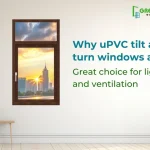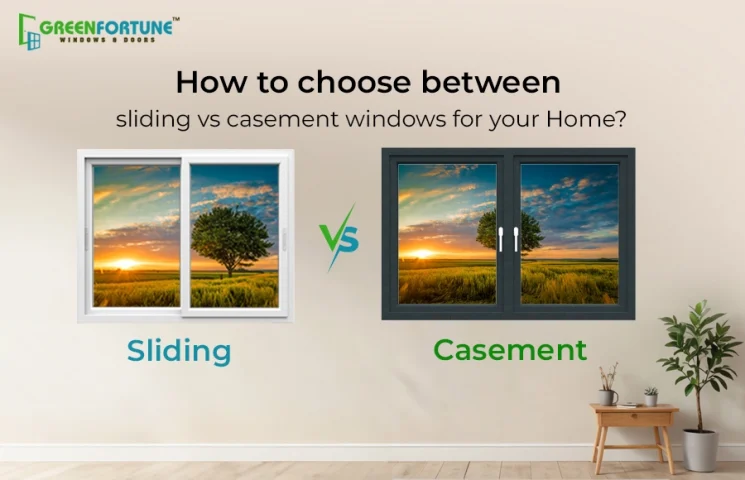
Why uPVC Tilt and Turn Windows Are Good for Lighting and Ventilation?
September 20, 2024
How to Stop Water Leakage from the Wall: A Step-by-Step Guide
September 23, 2024Sliding and casement windows are two of the most common types of windows installed in a building. With some rather unique features and benefits, each of them caters to different needs and tastes. Let’s understand these two window types and their unique features so that you can make an informed decision for your home.
uPVC sliding windows
How they work
As the name suggests, uPVC sliding windows operate horizontally. The operation is very simple; the sash moves from side to side to open and close. Their very simple design is why sliding windows are suitable for every space and location where any other type of design might be either impractical or prohibitive. Their simple and versatile design makes them an easy preference for any homeowner.
Advantages
There are several other characteristics of the uPVC sliding windows that make them particularly important, the major one noted is the fact that they do not require an extra space to open, making them ideal in a room with limited space or any other place where you would not like your windows causing hindrance in free movement.
Sliding windows are also highly recognized for ease of use. They run with ease on their tracks, which is very convenient with wide windows or windows that may be in hard-to-reach areas when on the outside. Aesthetically, sliding windows create a smooth, feel that matches modern house designs. It has clean lines and a minimalistic appearance, providing your house with more curb appeal.
Considerations
While there are many advantages to sliding windows, they also have some distinct set of disadvantages. The major problem can be the maintenance of tracks due to dirt and other debris collected over time. Since dirt can cause blockage, timely cleaning of tracks is essential for the smooth operation of windows. Also, the rubber gasket seal can crack over time causing energy efficiency problems and increasing the burden on heating and cooling systems.
uPVC casement window
How They Work
In contrast to sliding windows, uPVC casement windows are attached with hinges or friction stays and open inward or outward. For the same size of window, a casement window offers more opening, open view and better ventilation compared to sliding windows. The crank mechanism makes opening and closing these windows feel like a breeze, making them suitable for areas such as the kitchen that may have smaller walls but require better ventilation.
Advantages
The casement windows have several advantages, particularly with energy efficiency. Offering naturally airtight seals, they can prevent any draught and possible leakages of air to the outside—improving insulation. The tighter seal helps more effectively to maintain the indoor temperature.
On the other hand, the full opening provides better ventilation than sliding windows that only allow partial ventilation. This can be very advantageous in rooms needing more flow of air. Another additional benefit is that uPVC casement windows are much easier to clean, which is a valuable quality of the feature in case the windows are in difficult-to-reach areas.
Considerations
One of the things to consider regarding casement windows is the space that they take. Since the window swings in or out while opened, there needs to be enough space outside the window to allow it to fully open. This might be difficult in constricted places, places where space outside is limited, or near other landscaping and walkways.
Furthermore, such a design may tend to be more easily prone to damage by winds or accidental impact if not closed on time. This means that they may end up damaging more often compared to sliding windows.
Sliding Casement Window
If you like the ease of operation of sliding windows and the style of casement windows, sliding casement windows s offer a unique solution. These simple windows are fundamentally sliding windows but lock the centre just like casement windows. They offer a great middle ground for anyone interested in the style of casement windows but is limited by space.
Making Your Decision
Put Yourself in Your Space
Consider the position of the window with respect to a pathway or any other furniture or appliance that you would want to place. Sliding windows will be best used when there is not much outdoor space or when you do not want to block any pathways.
For casement window examples, they can be installed in rooms next to active patios or walkways. Casement windows, however, need some space on the outside to fully open.
This makes them more suitable for locations where you have the freedom to accommodate the outward or inward swing of the window.
Realize Energy Savings
Energy efficiency is one factor to consider for windows. When closed, casements are typically tighter and give better insulation, which saves the energy cost. This helps maintain a rather constant indoor temperature due to fewer chances of drafts. Over time, sliding windows show reduced sealing that can lead to energy leakage. Hence, for extreme energy efficiency concerns, casement windows have the upper hand.
Assess aesthetic preferences
Aesthetics is where windows largely come in since they not only provide light and ventilation for your home but also become a significant part of altering your property's character. This clean line and minimalistic look easily blend with contemporary architectural styling evident in most modern homes.
Casement window is one of the oldest styles of windows so it adds a traditional appeal to your home. Sliding windows have become more popular in modern times and offer a contemporary look.
Evaluate Maintenance Needs
Windows are one of those elements of a house that stay in place for years. Therefore, the ease of maintenance becomes an important factor in choosing the right type of windows. Since sliding windows run on tracks, the space in between tracks is susceptible to collecting dust over time. This dust and dirt can impact the free movement of uPVC sliding windows and thus require timely cleaning, which can sometimes be challenging due to the limited space available. Similarly, cleaning the glass from the outside can be challenging for these windows. uPVC casement windows are much easier to clean, be it their frame or glass.
Proceed with consideration and reflection on how much time and effort you are willing to put in to maintain your windows by establishing your priorities/preferences.
Conclusion
Therefore, when choosing between sliding and casement windows, one needs to take into consideration several aspects, such as space, energy efficiency, aesthetics, maintenance, and budget. Sliding windows are suitable when a person has a case of modern design with less space and for easy operation, giving one a sleek look.
On the other hand, the casement window is very good for ventilation and energy-efficient, relatively easy to clean since the casement sash can swing widely, but it takes more space to open outward.
Armed with these, you can make an entirely educated decision to enhance yours with improved functionality and style. Make your arrangements by choosing basically between a modern feel with a sliding window from the casement windows that bring forth timeless features. Each has amazing potential to provide comfort and beauty to any home.
Discover GreenFortune, Your Partner in Quality uPVC Windows and Doors
At GreenFortune, we are proud to offer high-quality uPVC windows and doors at affordable prices. We offer and install a variety of window types for all homes with both durability and aesthetics in mind.
Contact us to find out more about the uPVC window design that we offer. Whether you are renovating your existing home or building a new one, partner with us to elevate the comfort levels and energy efficiency in addition to the style quotient of your space provided by our superior-quality uPVC windows.
FAQs
Are Sliding Windows More Energy Efficient Than Casement Windows?
Generally speaking, casement windows are said to be more energy-efficient compared to their sliding counterparts. When closed, the seals on a casement window fit much tighter, allowing very minimal drafts and heat loss in this area. This, therefore, contributes immensely towards ensuring better insulation, hence lower costs in heating and cooling. Sliding windows may not lock that seamlessly and can sometimes allow energy out over time due to the degradation of seals; although they can prove to be very handy due to space-saving benefits, especially in homes or apartment buildings where windows may need to serve more than the regular purpose of providing an egress and ingress for one's property. Both might vary due to energy efficiency related to window type, quality of materials, and installation.
Can casement windows be installed in places with limited space and little or no room outside?
The major drawback of casement windows is that they require adequate external space for them to open fully. In cramped or narrow areas, a casement window becomes a hindrance. If there is little room or if the window faces some paths, landscaping, or such, then a casement window may not be appropriate. In such situations, a sliding window may be more feasible, as it opens sideways and does not require extra external space.
Which has higher maintenance needs between the Sliding Window and the Casement Window?
In general, sliding windows require more maintenance compared to casement windows. Dirt and other materials can cling to the tracks of the sliders, which may build up and require periodic cleaning to keep them running smoothly. In general, casement windows are easier to clean from the inside, as they open outward for easy access to both sides of the glass without needing to go outside. While both window styles do take some degree of maintenance, casement windows are generally easier in this regard.








